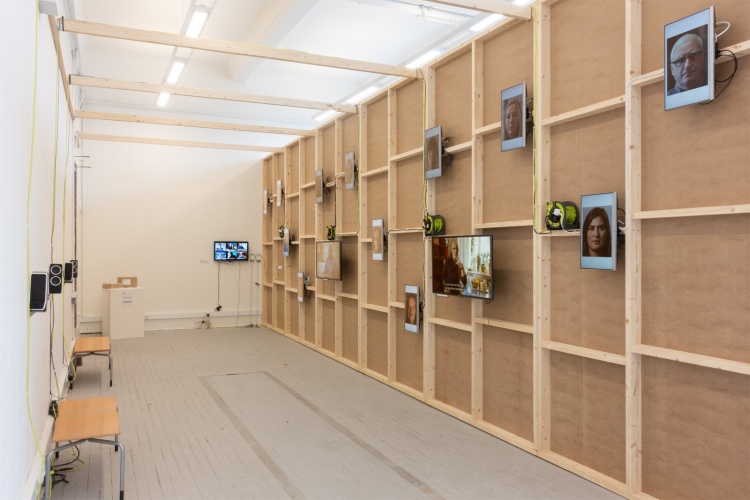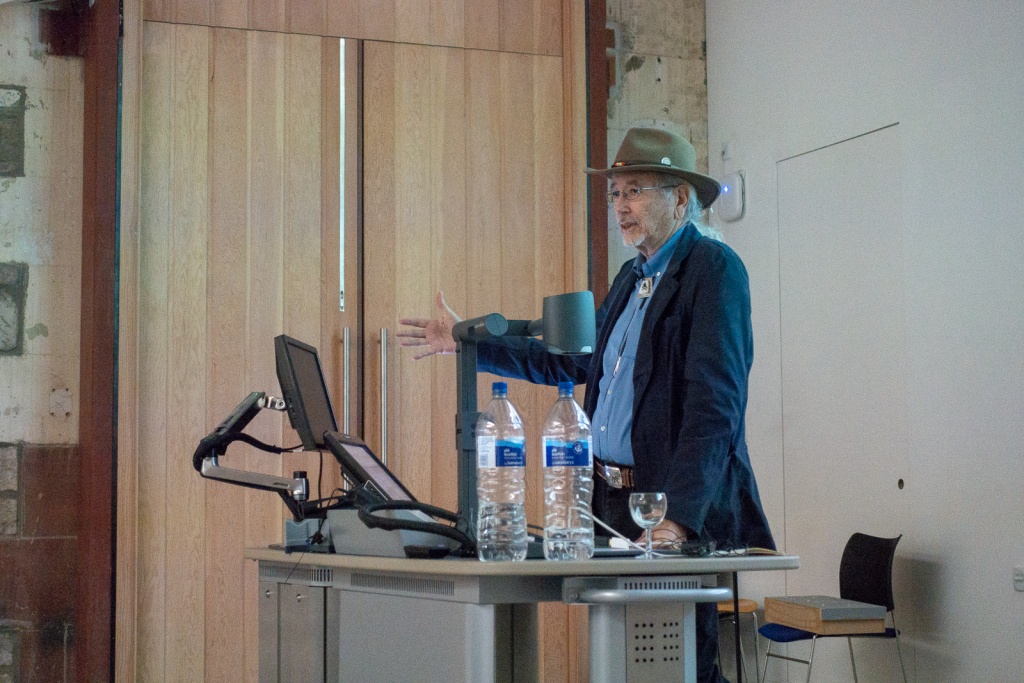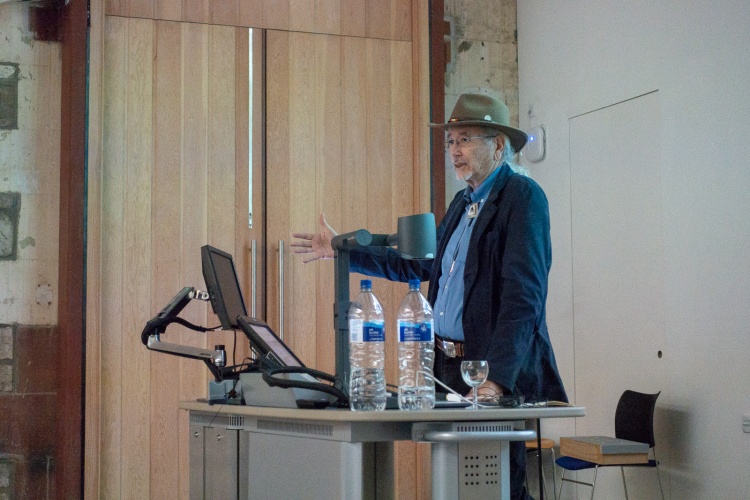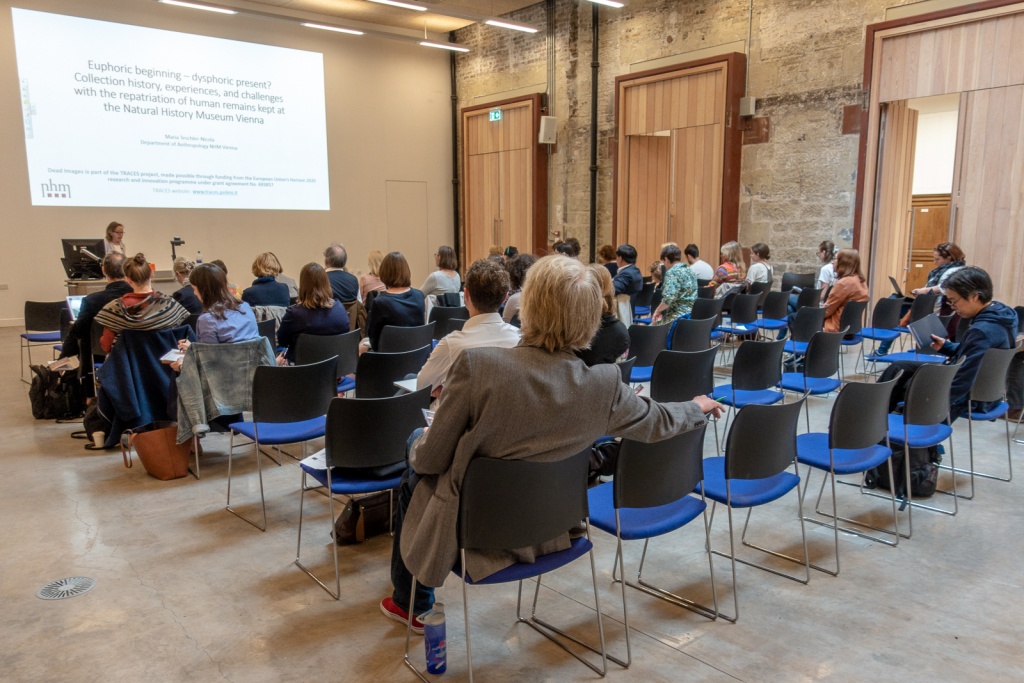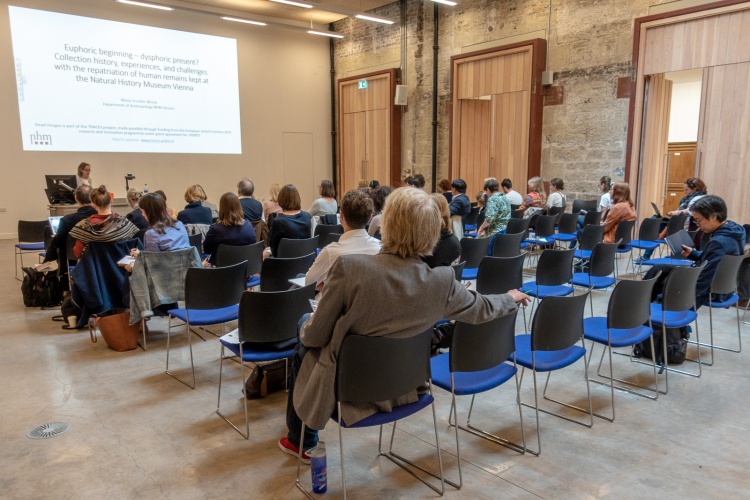by Callum Fisher on 12 September 2018
Reflections on the Dead Images Conference and Artistic Research
by Callum Fisher on 12 September 2018
At the physical and conceptual heart of the Dead Images exhibition is a photograph. This image has the power to shock and to awe, but it would be incorrect to say that this is the aim, or even to suggest that the photograph is the central focus. Rather, the key to the project lies in the thoughts and feelings that are elicited and the way that it is possible to move beyond the image and question ourselves, or the world around us. How does the exhibition invite us to do so and why is this important?
The photograph at the centre of the exhibition is indeed significant and the vast spaces dedicated to it do suggest as much. In its extremely high resolution and 1:1 scale, however, the image implies a more significant connection to its tangible counterpart: a 30m long cabinet, holding over 8000 skulls in the anthropology collection of the Natural History Museum (NHM) in Vienna. Upon entering the exhibition, the visitor is faced with a series of videos that problematize the image. In one video, a curator at NHM refers to human remains in the collection that were “taken in a context of injustice”. To touch very briefly on what “injustice” may mean, the museum houses, for example, the remains of Māori tūpuna (or ‘ancestors’) that were added to the collection in the 19th century and the skulls of numerous individuals that were catalogued and measured in attempts to justify Nazi-era theories of racial hierarchy. Additionally, the photograph of the cabinet of skulls in the NHM features a large doorway that leads to a room that today houses the museum’s photography collection. Included in this collection are thousands of images of living people, taken in many cases without active consent, reduced to anthropological measurements by the gaze of the photographer.
The Dead Images conference and opening events on the 28th and 29th June were an opportunity to reflect on these problematic aspects of the collection’s history and the wider ethical questions it raises, adding new contributions to the growing body of research linked to the exhibition. The conference, then, forms a layer of critical discourse that, upon further consideration, can be understood as part of the artistic concept that originated in a desire to think more about a problematic collection of skulls. The contributions at this event are, thus, thoroughly entangled with the collection and the work of art itself. From the photograph, to the conference, including all related research, Dead Images is continually unfolding in expanding processes of knowledge production, seeking to understand its context but also to influence it. Thinking about Dead Images in particular, how can we characterise the relationship between the conference and the exhibition and what can this tell us about the boundaries between ‘art’ and ‘research’?
Among his first words at the opening event, Tal Adler, the artist and researcher at the heart of the project, affirmed that the exhibition questioned itself. Whilst this is certainly true, it only tells a partial story. Speaking to a room of artists and academics from vastly different disciplinary and cultural backgrounds – each one invited to reflect on their own practices – Tal did not fully express how these reflections in turn become part of the artwork in the context of an exhibition that is deeply entangled in research processes. Rather than art that questions itself, might we instead be able to imagine that the art lies in the questions asked, both of ourselves and of cultural institutions?
When writing about artistic research, specifically in the field of anthropology, Arnd Schneider asks us to engage in “a profound reflection on the relationship of the research process to the final work, whether we call it art or anthropology” (2008: 188). The focus on the research that contributes to, results from and constitutes part of the work of art is, in the case of Dead Images, a principal tenet of the project’s methodology. Dead Images is part of the wider, overarching TRACES project (Transmitting Contentious Cultural Heritages with the Arts) uses an innovative research model seeking to foster long-term partnerships between heritage institutions, researchers and artists in what Adler has labelled a ‘creative co-production’ (CCP)[i]. One of his guiding principles was that of working together with institutional partners, in this case the NHM in Vienna, in order to enact significant and sustainable change. In working with these partners, the project seeks to provoke new reflections on the treatment of difficult aspects of the past. Dead Images, then, is not simply an exhibition created as a response to the museum’s collection. It is frequently asserted within the team, that the exhibition cannot exist without its accompanying conference and comprehensive education programme, with the contextualisation of ethical debates being key to the concept. It is with these ideas in mind that I will be discussing the conference and opening event of the Dead Images exhibition.
In the exhibition, much of the content takes the form of videos constructed from interviews conducted over the past year, where physical and social anthropologists, artists, academics and activists share their views on Vienna’s osteological collection and its subsequent photographing. Tal offered a disclaimer at the opening event, affirming to attendees that he is indeed aware of the narrative his videos create. There is no such thing as a neutral film, he assures us; “From the very first cut, when you put two shots together, a decision has been made”. It is impossible to reflect on the conference without drawing parallels with the exhibition to which it is tied. In the videos, ideas flow from an interview with one person through to the next, with a narrative structure that emulates a dialogue. For example, a conversation is simulated in one video between Sabine Eggers (a bio-archaeologist at the NHM in Vienna), June Jones (a bioethicist from the University of Birmingham) and Te Herekiekie Herewine (repatriation manager at the Museum of New Zealand Te Papa Tongarewa) as they discuss the possibility of conducting intrusive research on Māori human remains held in the osteological collection. What is interesting about this and other sequences in the films is that they represent conversations that may have happened, but in a lot of cases are yet to happen. Many of the simulated conversations begin to take form only in the dialogical context of the conference. The videos are largely pre-emptive, hinting at situations that are yet to take place, referring to an imagined reality of future discussions.
Following the conference and as time passes, the videos become imbued with a deeper significance, referring to wider processes of dialogue and knowledge transfer that have come to pass. With the knowledge that the conference and an education programme were always destined to play an integral role in the project, it is thus apparent that the exchange of knowledge and best practice, pre-empted in the way that interviewees are seen to ‘respond’ to each other in the video interviews, was carefully choreographed to take place. These are the decisions and the narratives that Adler referred to in his introduction. The conference, or performative dialogue, forms part of the artwork that it discusses, highlighting the place of knowledge transfer in the project.
In an effort to be concise, I will avoid a simple retelling of the content of the presentations and will place the conference in its wider context of an artwork that imagines itself to be an unfurling package of knowledge production that helps enact change. Referring back to my previous observation that in this case the questions raised are themselves as much part of the artwork as the photograph at the exhibition’s centre, I will focus instead on the instances where questions were posed. The videos in the exhibition show the interviewees’ responses, but the questions asked are largely absent. When questions are posed in the videos, however, they are left hanging in the air as a suggestion, perhaps, that the sorts of ethical dilemmas raised about the treatment of human remains do not have simple answers. In the conference’s flesh and blood reflections of the simulated ‘conversations’, time was allocated to questions and answers. Through these enquiries and the responses given, we can read something of the process of knowledge transfer. In this situation of art become reality, the questions demonstrate the exhibition’s movement beyond the walls of the gallery into the public sphere. That the first presentation of the day was very closely linked to the collection housed in the NHM and the last, given by James Riding In of Arizona State University, focused on wider themes of justice and human rights, is not without incident.[ii]
Maria Teschler-Nicola, former curator and head of the Anthropology Department at the Natural History Museum in Vienna, was the first to present, contextualising the osteological collection with a description of the measures she had taken to address the problematic aspects of its history. The first session of the conference saw contributions from Teschler-Nicola and Sabine Eggers, current curator of the international osteological collection of the NHM in Vienna. Whilst they looked primarily at issues relating to the collection that had been photographed for Dead Images, conversation soon moved away from this. The first question of the day went to Larissa Förster (CARMAH, Humboldt University of Berlin) who asked how a specific case of repatriation of the remains of Klaas and Trooi Pienaar to South Africa may have provoked institutional change in the way that the NHM deals with repatriation requests. Whilst Teschler-Nicola’s answer, giving a purely personal response to a question about institutional change, would merit its own analysis, it is interesting and indeed evident that in asking this question, Förster began to move away from discussions related specifically to the collection into the wider domain of institutional practices.
Later, Paul Turnbull from the University of Tasmania spoke of the place of the dead in Australian memory and history, referencing “materialism’s triumph over religious consideration”. In response, Karin Witschke-Schrotta, also of the NHM in Vienna, shared her view that certain practices are not inherently opposed to religious considerations: “That’s how we do science!” Though her comments could be seen as provocative, they elicited a calm affirmation from Turnbull, that he, “can’t see how it ever stacks up against the good of repatriation.” Here, the discussion is again not specifically about the collection or the photograph, but about the questions around one’s discipline that they may raise. In the videos, opposing opinions such as these are placed side by side in a way that may suggest a conflict between the two, but during the conference, such imagined conflicts take form and become reality, moving beyond the simulation of the video.
Elsewhere, Regina Römhild, (Institute for European Ethnology, Humboldt University of Berlin), responded to the presentation of Elise Smith, historian of medicine and life science in Britain and the British Empire at the University of Warwick, asking her whether she had reflected on the deep entanglement of anthropology in colonialism and questions of racial science. Smith explained that she may not be best placed to talk about the history of another discipline, but Römhild elaborated, asking if knowledge of this history could lead to reflections on the way in which we produce knowledge more generally. Do we challenge our critical concepts? Though directed at Smith, these questions seemed intended for the wider audience. As in the videos, where people discuss their own disciplinary practice in relation to the osteological collection in Vienna, Römhild takes this reflection and extends it towards those in the audience, giving it form in the public sphere. Thus, in making public the questions raised by the artwork or, rather, in vocalising the questions that the artistic engagement invites us to consider, Römhild, Förster and others became implicated in the research process.
It is in discussing their research in the spaces between presentations, in the coffee breaks and post-conference drinks that the simulated dialogue and imagined reflections of the exhibition were made real. Schneider calls for us to consider the relationship between research processes and a final work of art, but this implies a separation between ‘research’ and ‘art’, which in the case of Dead Images and the TRACES project, does not exist. It would be both reductive and incorrect to consider the Dead Images conference simply as a reaction to a work of art or as a supplement to it. Rather, it is the beginning of a process of materialisation of the empty spaces between videos in the exhibition. These reactions in turn become entangled in the research process which neither precedes, accompanies, nor simply examines the artwork. Larissa Förster’s question about institutional practices, Karin Wiltschke-Schrotta’s declaration that it is simply how they do science, or Regina Römhild’s request to reconsider processes of knowledge production are in a sense choreographed to be part of an unfolding of knowledge, where the boundaries between art and research are blurred.
Coming back to the photograph at the heart of the exhibition, we can observe that although it does act as a catalyst for further discussion and plays a vital role in the project, the importance of moving away from this image to explore our own practices, critical thinking and institutionalised processes of knowledge production is deeply embedded in the content of the exhibition. The simulated dialogues or questions raised in the spaces between interviews became real discussions at the conference, as people from different disciplines met to discuss their thoughts and ideas. They were not reacting to an artwork, but bringing the questions raised in the artistic engagement into the public sphere. They were participating in the production of knowledge, seeking to understand the wider context in which the project is situated but also striving to influence it. Though Dead Images is indeed a project with a photograph at its centre, one cannot escape the conclusion that it is more than that; it doesn’t end with the four videos in the exhibition, nor with the conference. Seeking, as I have been, to understand the project, I am drawn back to the deep entanglement between art and research and the impossibility of separating the two. Bearing this in mind, I will finally return to my initial proposal of moving beyond the notion of art that questions itself, to affirm that this is indeed an exhibition where the art lies in the very question.
References
Schneider, Arnd. 2008. “Three Modes of Experimentation with Art and Ethnography”, Journal of the Royal Anthropological Institute, 14 (1): 171-194.
Notes
[i] See the TRACES website for more information on the project’s methodology http://www.traces.polimi.it/, accessed on 10 August 2018
[ii] For further information on the conference speakers and to consult a copy of the conference brochure, see: http://dead-images.info/conference-2/, accessed on 10 August 2018
Callum Fisher is a student of the European Masters on the Dynamics of Cultural Landscapes and Heritage Management. During his Erasmus+ internship, he was based at the Centre for Anthropological Research on Museums and Heritage in Berlin and contributed to the EU Horizon 2020 funded TRACES project, addressing the contentious heritage of collections of human remains held in European museums.

